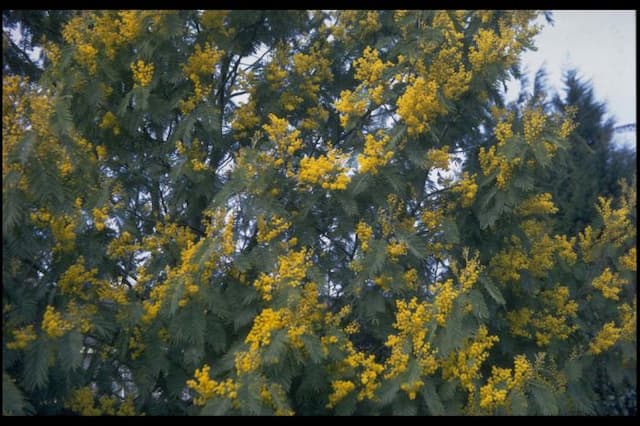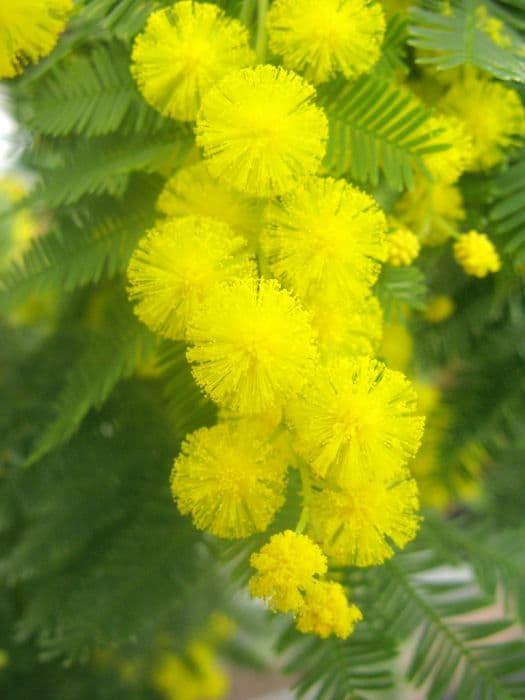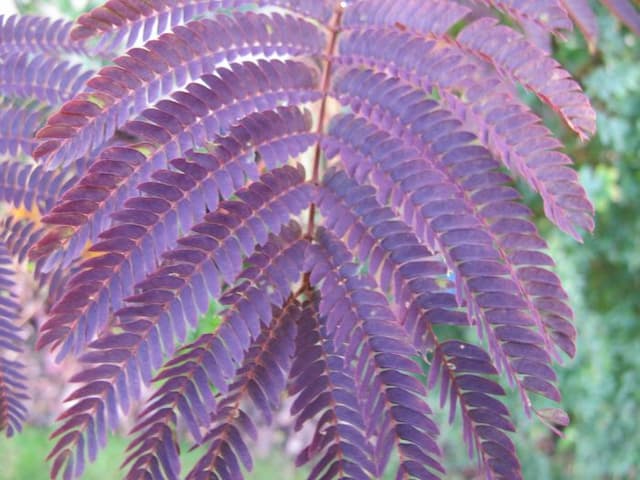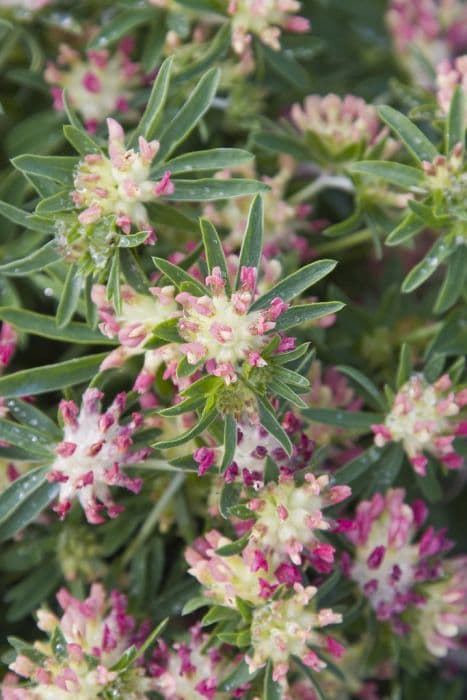Lupin Lupinus 'The Page' (Band of Nobles Series)

ABOUT
The plant Lupinus 'The Page' (Band of Nobles Series), commonly known as Lupin or Lupine, is an ornamental plant celebrated for its beautiful and striking flower spikes. It is characterized by its vibrant deep carmine-red blossoms that stand out in any garden setting. The flowers are densely packed on a long, upright spike, creating a dramatic display that can attract the eye from a distance. Each individual flower that adorns the spike resembles that of a pea flower, which is no surprise as Lupins are part of the legume family. The petals have a standard shape with an uplifted banner, wings, and a keel, making them intricate and charming up-close. The foliage of the Lupine consists of palmate leaves, which means the leaves radiate out from a central point, similar to fingers from the palm of a hand. Each leaf is comprised of several leaflets, usually between 5 to 9, which are narrow and may have a slightly hairy texture. The leaves are often deep green, providing a perfect backdrop to the magnificent flower spikes. When not in bloom, the foliage itself makes an attractive plant due to its bushy, lush nature, and the texture the leaves bring to the garden environment. The overall appeal of the Lupinus 'The Page' lies in its floriferous nature, with the blooms providing a significant color impact. It's popular among gardeners for its ability to add height and structure to garden borders without the detail of its dimensions, as well as for the richness of its red blossoms that can pair well with a variety of other plants in a garden design.
About this plant
 Names
NamesFamily
Fabaceae
Synonyms
The Page Lupine, Band of Nobles Series Lupin, The Page Lupin
Common names
Lupinus 'The Page'
 Toxicity
ToxicityTo humans
Lupine, including 'The Page', contains alkaloids that can be toxic to humans if ingested. The most common symptoms of lupine poisoning include dizziness, confusion, nausea, vomiting, and respiratory depression in severe cases. The highest concentration of these toxic compounds is typically found in the seeds and seed pods, but all parts of the plant can be harmful if consumed in significant quantities. Ingesting lupine can lead to potential consequences such as bradycardia (slow heart rate), hypotension (low blood pressure), convulsions, and in extreme cases, may be fatal.
To pets
Lupine, including 'The Page', is toxic to pets if ingested. The alkaloids present in lupine can cause symptoms such as lethargy, vomiting, diarrhea, tremors, and seizures in pets. All parts of the plant are poisonous, with the seeds and pods being particularly high in alkaloid content. Ingesting lupine can result in severe poisoning, leading to potential complications such as neuromuscular paralysis or respiratory failure, and can be fatal if not treated promptly. Pet owners should prevent their animals from consuming this plant to avoid potential toxicity.
 Characteristics
CharacteristicsLife cycle
Perennials
Foliage type
Deciduous
Color of leaves
Green
Flower color
Red
Height
3 feet [0.91 meters]
Spread
2 feet [0.61 meters]
Plant type
Herb
Hardiness zones
4
Native area
Mediterranean
Benefits
 General Benefits
General Benefits- Ornamental Appeal: Adds vibrant color to gardens with its deep red to carmine flowers.
- Attracts Pollinators: Invites bees, butterflies, and hummingbirds, promoting biodiversity.
- Nitrogen Fixation: Improves soil fertility by fixing nitrogen through its root nodules.
- Drought Tolerance: Once established, it requires minimal water, conserving resources.
- Easy to Grow: Adaptable to a variety of soil conditions and not demanding in terms of care.
- Seasonal Interest: Flowers from late spring to early summer, providing visual interest during these seasons.
- Erosion Control: Its root system can help stabilize soil and prevent erosion on slopes.
- Companion Planting: Serves well with other species in a mixed border or flower bed for enhanced aesthetic diversity.
- Deer Resistance: Not a preferred choice for deer, reducing the likelihood of damage from wildlife.
 Medical Properties
Medical PropertiesThis plant is not used for medical purposes.
 Air-purifying Qualities
Air-purifying QualitiesThis plant is not specifically known for air purifying qualities.
 Other Uses
Other Uses- Dye Production: The deep red and purple flowers of the Lupine can be used in the production of natural dyes for textiles.
- Photography Subject: Due to their vibrant colors and stately appearance, Lupines are often used as subjects for botanical photography and art.
- Educational Tool: Lupines are used in schools and educational programs to teach students about plant biology and hybridization.
- Craft Projects: Dried Lupine flowers can be used in craft projects, such as making floral arrangements or potpourri.
- Green Manure: When plowed into the ground, Lupines act as green manure, enriching soil with nitrogen and organic matter.
- Erosion Control: The Lupine's robust root system makes it useful for stabilizing soil and preventing erosion on slopes.
- Habitat Restoration: Lupines are sometimes planted as part of wildflower mixes to restore native habitats and support wildlife.
- Butterfly Gardens: Lupines are known to attract butterflies, making them a good choice for butterfly gardens and pollinator-friendly landscapes.
- Garden Borders: With their tall spikes, Lupines are often used to create dramatic borders in garden design.
- Culinary Garnish: Although not widely recognized as edible, the colorful blossoms of Lupines can be used to garnish dishes and provide visual appeal.
Interesting Facts
 Feng Shui
Feng ShuiLupine is not used in Feng Shui practice.
 Zodiac Sign Compitability
Zodiac Sign CompitabilityLupine is not used in astrology practice.
 Plant Symbolism
Plant Symbolism- Imagination: The Lupin is often associated with imagination due to its variety of colors and dramatic appearance, which inspires creativity and fantasy.
- Innovation: Because Lupins are known for their ability to improve the soil with nitrogen fixation, they symbolize innovation and the ability to make the environment better.
- Devotion: The Lupin, with its tall and sturdy spikes, is seen as a symbol of devotion or steadfastness in various cultures, representing an unwavering commitment.
- Opportunity: Some traditions hold that Lupins symbolize an open door or opportunity, as they often thrive in the wild by taking root in new and challenging locations.
 Water
WaterLupines, including 'The Page', should be watered deeply but infrequently to encourage strong root development. Water the lupine with approximately 1 inch of water each week, increasing to twice a week during prolonged periods of drought or extreme heat. Aim for the water to penetrate the soil to a depth of around 8-12 inches. If rainfall is sufficient, additional watering may not be necessary. Reduce watering in the winter when the plant is dormant. Always check the soil moisture before watering to ensure the soil is not waterlogged, which can lead to root rot.
 Light
LightLupines like 'The Page' thrive best in full sun with at least 6 hours of direct sunlight each day. They can also tolerate partial shade, but too much shade can result in fewer blooms and a leggy growth habit. Place the plant in a location where it will receive ample sunlight throughout the day for optimal growth and flowering.
 Temperature
TemperatureLupines, including 'The Page', prefer a moderate temperature range and can generally tolerate temperatures as low as 20°F and as high as 75°F. They grow best when daytime temperatures are between 60°F and 70°F. Lupines may struggle or require protection if temperatures drop below 20°F or exceed 75°F.
 Pruning
PruningPrune lupines like 'The Page' to maintain their shape and encourage more blooms. Deadhead spent flowers regularly to prevent the plant from using energy to make seeds. Cut back the flowering stalks to the base in late summer after blooming has finished. Additionally, remove any yellow or dead leaves to keep the plant looking tidy. Pruning is usually done post-flowering and may be required a few times throughout the blooming season.
 Cleaning
CleaningAs needed
 Soil
SoilLupins prefer slightly acidic to neutral soil with a pH of 6.0 to 7.0. A well-draining soil mix rich in organic matter ensures healthy growth. Amend the soil with compost and peat moss to improve fertility and drainage.
 Repotting
RepottingFor Lupins, repotting is not often necessary since they are typically grown as annuals or perennials that are left to grow in one place. However, young plants can be repotted annually until they reach maturity.
 Humidity & Misting
Humidity & MistingLupins, known commonly as lupines, do best in moderate humidity levels; they can tolerate some variation, but do not require high humidity to thrive.
 Suitable locations
Suitable locationsIndoor
Ensure bright light, cool temperatures, and keep the soil moist.
Outdoor
Plant in full sun and well-draining soil; space adequately.
Hardiness zone
4-8 USDA
 Life cycle
Life cycleThe Lupinus 'The Page', commonly known as Lupin, starts its life as a seed which germinates in spring when soil temperatures rise. The seedling emerges and establishes a deep taproot while developing its characteristic palmate leaves. As it grows, the Lupin enters the vegetative stage, producing robust foliage and elongating its stems in preparation for flowering. The reproductive stage follows, typically in late spring to early summer, where vibrant, tall flower spikes emerge, showcasing deep red to pink pea-like flowers that attract pollinators. After pollination, the flowers develop into seed pods that mature by late summer, eventually drying and releasing seeds for the next generation. The Lupin then enters a period of dormancy over the winter, especially in colder climates, completing its annual life cycle.
 Propogation
PropogationPropogation time
Spring to Summer
The Lupin or Lupinus 'The Page', part of the Band of Nobles Series, is typically propagated by seed. The best time to do this is in spring after all danger of frost has passed. To propagate by seed, you should soak the seeds in water for 24 hours to soften the hard seed coat. After soaking, sow the seeds 1/4 inch deep in a seed starting mix. Make sure to space them about 12 inches apart to give each plant room to grow. The seeds usually germinate in 14 to 28 days, and you should keep the soil moist but not saturated during this period. Once seedlings emerge and establish a set of true leaves, they can be transplanted to their final growing location.









